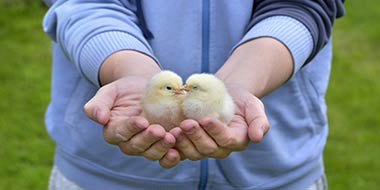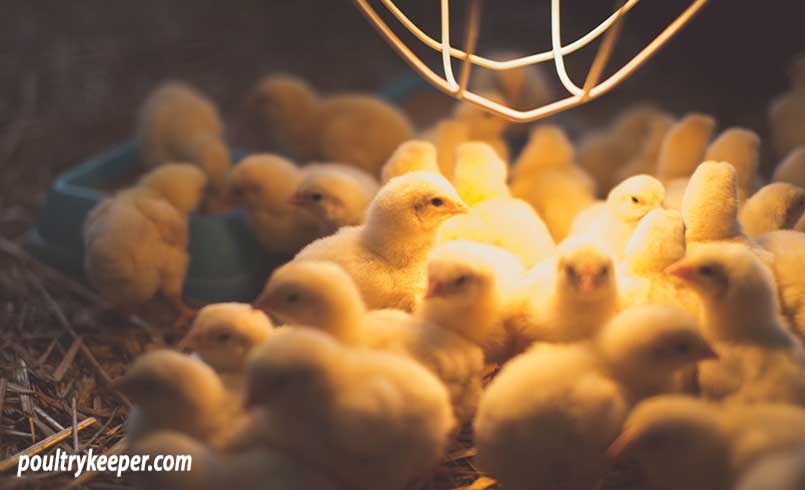
Chicks hatched in an incubator have no Mother Hen to keep them warm. Without care and warmth, they won’t survive, so you need to have a brooder ready before they start to hatch.
If you’ve ordered some day-old chicks, they too will need a brooder waiting for them. Even if you use a broody hen for hatching, it’s a good idea to be aware of what is required for artificial brooding in case of emergencies. In this article, I explain how to set up a brooder for raising chicks at home.
What is a brooder?
A brooder is quite simply a contained area that provides a warm and safe environment for raising chicks.
Extra warmth is necessary for the first 4-5 weeks until they have grown their feathers.
You can supply this with a heat lamp or an electric panel heater like the Brinsea Ecoglow that’s keeping these chicks warm in this photo.
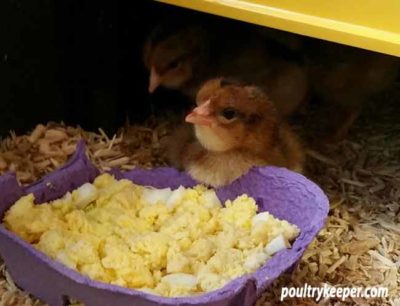
Making a brooder
You can buy a brooder, but it is easy to make one using whatever is readily available.
A good-sized cardboard box is often the easiest option for a few chicks raised indoors, with the advantages of being free and disposable.
One drawback is that cardboard quickly becomes soggy, especially when brooding waterfowl. Damp conditions are dangerous for young birds and can lead to Coccidiosis. It’s essential to keep the brooder clean and change bedding frequently.
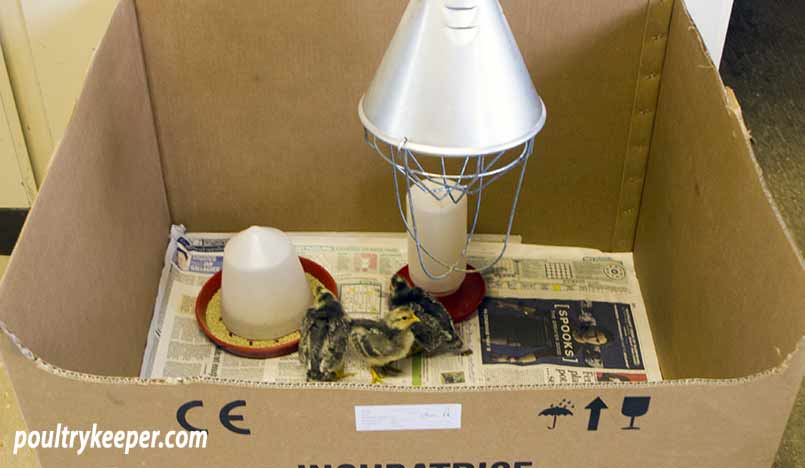
Other ideas are a plastic storage box, a child’s sandpit or paddling pool, a deep wooden drawer or crate – a friend uses a plastic indoor rabbit cage. This works well, being easy to clean and with the wire cage’s added security, but would need some extra draught protection in most environments.
Like Victorian ladies, chicks don’t like draughts, so the brooder must protect them from sudden temperature changes whilst allowing plenty of ventilation.
Make sure your intended brooder is roomy enough. While all the chicks should be able to congregate under the warmth of the heat lamp, there must also be an unheated part of the brooder where they can eat, drink and exercise.
Bear in mind, too, that wobbly little chicks grow surprisingly quickly into lively, energetic young birds and will need space to move around freely as they develop. Raising chicks in overcrowded conditions leads to disease and stress-related problems.
Chicks vary in size, according to their parents – small chickens produce tiny chicks compared to some of the heavier breeds, and quail chicks are minuscule! If the brooder looks too large at first, you can partition it with cardboard. You can remove it later to allow the chicks more space as they grow.
All young birds are very vulnerable, and the brooder should be covered with wire mesh to keep out curious pets and prevent escapes. Some chicks try out their little wings after only a few days, and it’s amazing how high they can jump!
Brooding enclosures
If you are raising chicks in larger numbers than can be accommodated in a contained brooder, a brooding enclosure will be required. You can buy plastic brooding panels, an adjustable brooding ring, make the pen out of pieces of cardboard taped together, or use a roll of corrugated card. Please make sure the sides are high enough to keep the chicks from escaping once they start to grow.
When brooding on this scale, a circular pen is required to prevent chicks from huddling in corners and suffocating each other. They should be relatively restricted while they are little to keep them close to the heat and food, but as they start to grow and become more active, you can increase it accordingly.
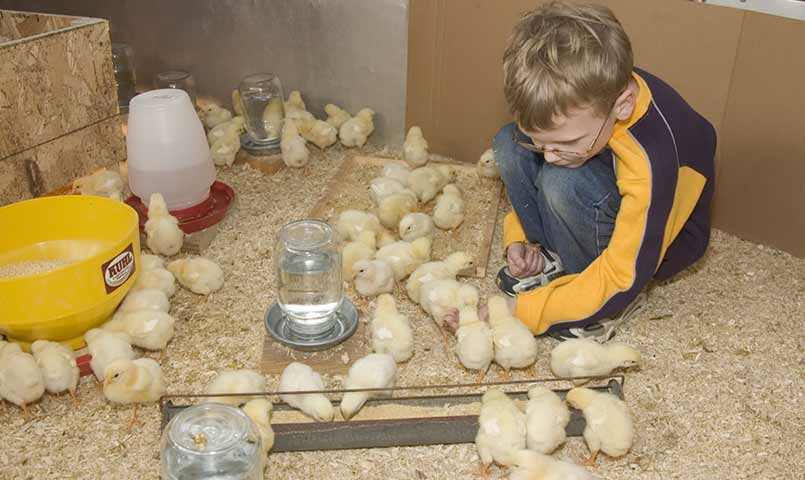
Where to put the brooder
For a small hatch, a quiet indoors room will probably be the best bet. Ideally, this should be where the temperature is reasonably constant, without lots of comings and goings to cause fluctuations.
As long as it isn’t draughty, the room doesn’t need to be incredibly warm and shouldn’t be too hot – be careful about using a conservatory in summer.
Chicks need light – either natural or electric – to develop correctly. They should also have some hours of darkness at night.
When choosing your site to raise your chicks, bear in mind that they produce quite a bit of dust and mess.
Raising chicks outside
Raising chicks outside is also possible. The brooder could also be placed in a suitable outbuilding or even in the coop where the young birds will eventually live.
As well as being free from draughts, the building must be completely rat-proof.
You will attract rats when they can get shelter, food and water. They can smell chicks and can kill them if they gain access.
Since rats are very good at getting into houses, cover wooden floors with wire mesh or a double layer of chicken wire.
- You can learn more about rats in my guide to getting rid of rats which helps you deal with rats around the chicken run.
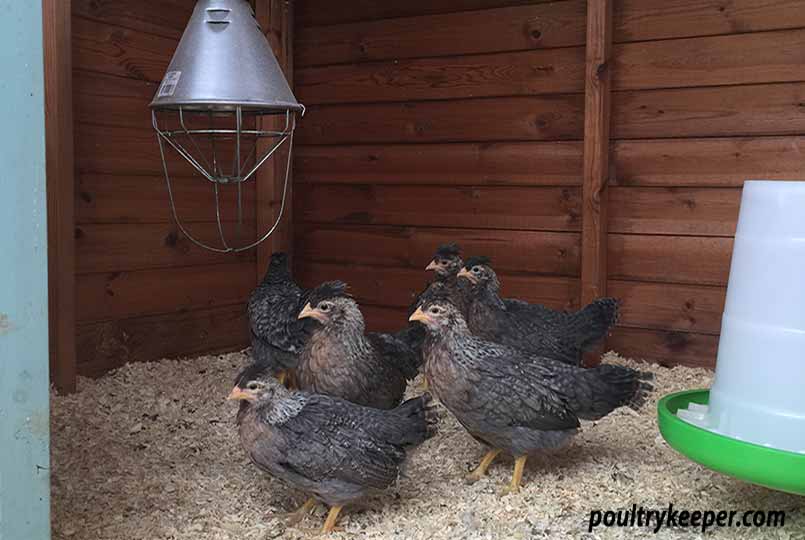
There must also be electricity for the heat-lamp, and either a good natural light source or electric lighting.
If you are using an extension lead, be sure it includes an RCD for protection, and you keep it dry, out of the rain. If you’re not sure what an RCD does, then this website explains it well.
A secure outbuilding is usually required if using a brooding enclosure.
What heat do chicks require?
A chick’s body cannot regulate its own temperature, requiring external heat to keep warm. We must provide this from the start of brooding until chicks are fully feathered (usually around 5-6 weeks) and gradually reduce the heat.
- Start the brooding temperature at 35°C (95°F).
- Reduce the temperature by 3°C (5°F) every week as the chicks grow bigger and start to develop feathers.
If you are raising a lot of chicks, they will also huddle together for warmth, and this is why they can be shipped around the country in boxes without extra heat. For example, in the U.S., chicks can be purchased and are regularly sent by mail.
Heat lamps
A traditional heat lamp, or ‘hover’ as it’s sometimes called in the US, consists of a powerful bulb with a metal shade suspended from a chain. Heat is increased by lowering the lamp and decreased by raising it.
A more up-to-date option is the electric panel, which consists of a heated plate with legs. The chicks go under this for warmth, as they would with a hen.
As the heat lamp is the most expensive part of the brooder, it’s worth taking some time to consider which type will suit you best.


Two different size heat lamps, both need to be hung securely with a chain.
Although chicks need light, if a white bulb is used for heat, they have no period of darkness to rest – this can lead to pecking problems caused by stress. Infra-red bulbs are better, while ceramic bulbs emit no light at all (but remember there will be no obvious indication if the bulb stops working).
You can buy heat lamps here.
The heat lamp must be fixed securely above the brooder – it would be disastrous for it to fall on to the chicks! It should be hung from a chain, attached to a ceiling hook.
Heat lamp bulbs get extremely hot and can pose a fire hazard, so make sure it is well away from cardboard and bedding. There should also be a wire guard around the bulb to protect the chicks (and the handler!).
One 250 Watt infra-red heat lamp can provide enough heat for up to 25 chicks.
Infra-red or ceramic bulb?
An infra-red heat lamp emits more infra-red radiation than a standard bulb. They can last about 30 weeks, but turning them on and off will reduce their life.
A knock or water splashes can cause them to shatter, so they are not recommended for ducklings.
Red light is proven to reduce feather pecking amongst chicks, but this is less common when small numbers of chicks are raised.
You can buy infra-red heat lamps here.
A ceramic heat lamp is made of porcelain and doesn’t give off any light. They are more expensive but can last for about five years.
Ceramic heat lamps don’t give off as much heat as infra-red lamps, so you will need to adjust your lamp’s height, but they do allow you to provide darkness at night by using a separate light on a timer or by using natural daylight.
You can buy ceramic heat lamps here
My choice for raising chicks is to use an infra-red bulb for the first four days, which provides the most heat and 24-hour light for chicks to start feeding and then switch to a ceramic lamp that provides slightly less heat and gives them darkness overnight to rest.
While the chain can be adjusted to lift the heat lamp as the chicks get older, and need less heat, if you want to be more environmentally friendly and save your electricity costs, you can also use lower power ceramic bulbs as your chicks get older. I have 250, 150 and 60 Watt bulbs that I use to cut the heat down and keep my energy bill down!
Whatever you choose, always keep a spare bulb handy.
Electric panel heaters
When you are raising chicks in small numbers, an electric panel heater is often a better solution. It is especially true indoors, where it is more challenging to secure a heat lamp, or you worry about fire hazards.
You can check Ecoglow 20 pricing here.
Apart from offering the closest alternative to natural brooding, there are several other advantages to this type of heater:
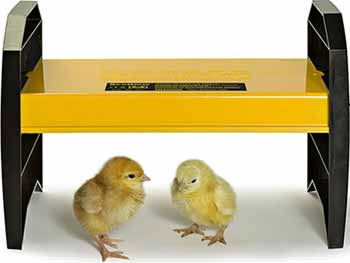
- Running costs are considerably cheaper than with a traditional heat lamp.
- The unit doesn’t get anywhere near as hot as a bulb, making it much safer.
- The heater stands on its own legs and doesn’t require hanging – this can be more convenient, especially when brooding chicks indoors.
- If brooding different sized chicks, the unit can be adjusted so that one end is lower than the other.
- The chicks have the added security of a hiding place where they can rest.
- In a small brooder a lamp can provide too wide an area of heat, but a panel heater only warms the space underneath it.
There are some considerations to bear in mind though:
- Panel heaters are more expensive to buy than heat lamps.
- Although panel heaters come in different sizes, a second one may be required if hatching operations expand more than anticipated.
- The panel provides less heat than a bulb, so may be less suitable for very tiny chicks in a particularly cold environment.
- The chicks can’t be easily checked when they are under the panel.
- Unless positioned carefully, a rectangular panel heater in a box brooder can create narrow spaces where chicks may become trapped.
- Chicks love perching on the heater, but droppings bake on and can be difficult to remove.
Drinkers and feeders
Buy a narrow-lipped chick drinker to prevent chicks from soiling their water, getting wet or drowning – all of which can happen with an open container.
A small feeder, ideally with a partitioned trough, keeps the chicks out of their food and stops them from scratching it into the bedding.
Standing the drinker and feeder on tiles, or suspending them just above floor level, helps keep water and food separate from the bedding. Please don’t make them too high, as stretching can cause the chicks developmental problems.
Always place the feeder and drinker outside the heated area.
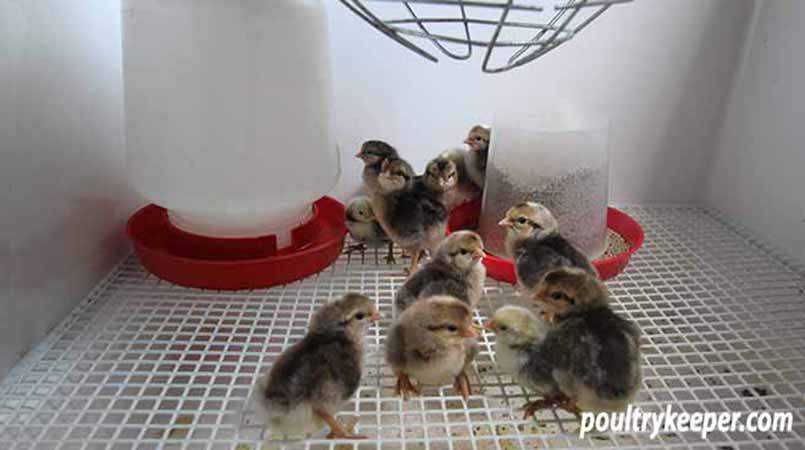
Feed and bedding
Chick crumbs vary in quality – buying the cheapest can be a poor economy as apart from possible nutritional deficiencies, the chicks may find them difficult to eat. Chick crumbs are a complete food, although it’s a good idea to supply some chick-sized grit too.
You can buy Chick Crumbs here, and there is more advice on feeding chicks and what to feed in an emergency here.
Dust-extracted shavings make good bedding, although there is the danger of small chicks eating them until they work out where to find their feed. For a small hatch, a thick layer of paper towels can be used in the critical first few days, and this has the advantage of being very easy to keep clean.
Newspapers may seem a practical solution, but it is too slippery at first and can lead to chicks with splayed legs. However, they can be useful for lining the bottom of the brooder, as long as you cover it with plenty of bedding.
Once chicks are a week old, you can usually use newspapers with care.
Preparing the brooder
Get everything ready in good time so that you can check it will all work correctly.
If the brooder has previously been used, it should be thoroughly cleaned, disinfected and allowed to air – in an ideal world, this would be done straight after the previous batch of chicks had moved out.
Cover the floor of the brooder with a good layer of bedding. If your brooder is a cardboard box, lining the bottom with an extra piece of cardboard or some newspaper will help absorb excess moisture. Auboise is a popular choice for brooders.
Set up the heat lamp or panel heater. A digital thermometer can be used to check the temperature, although the chicks will soon show whether they are comfortable.
Cold chicks huddle together, cheeping loudly, while too much heat causes them to move as far away from the lamp as possible. If they lay there panting, they are too warm, and overheating can cause fatalities.
Keep an eye on heat levels if the outside temperature is exceptionally high, remembering that things will cool down considerably at night.
Make sure the feeder and drinker are clean and ready and stock up with chick crumbs.
If you have set your incubator humidity correctly and have candled your eggs, everything is on track. All you have to do is wait for the eggs to hatch!
Please let me know how you get on in the comments below.

